M
Maclellanara (mac-LELL-an-AR-ah) A hybrid genus derived from Brassia, Odontoglossum and Oncidium, created in 1978 and named for the firm Rod McLellan Co., which created the genus. Now these hybrids are correctly, Brassidium.
Macodes (ma-KOH-deez) A genus of 14 species of terrestrial orchids from Java and Borneo, considered one of the "jewel orchids" because of the beautiful variegated foliage. It was described in 1840 by Lindley, the name alluding to the elongated midlobe of the lip.
Macradenia (mak-ra-DEN-ee-ah) A genus of 12 species of inconspicuous epiphytic orchids from tropical America, somewhat similar to Notylia. It was described by Robert Brown in 1822, the name derived from the Greek in reference to the long stipe connecting the pollinia to the viscid disk.
macranthum: Cyrtochilum macranthum has large flowers.
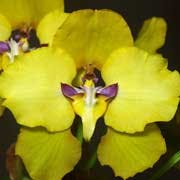
macranthus, -a, -um (ma-KRAN-thus) Large-flowered.
macroceras (mak-ro-SER-as) Large-horned.
macrochilus, -a, -um (mak-ro-KYE-lus) Large-lipped.
Macroclinium (mak-roh-KLY-nee-um) A Neotropical genus of 29 species of diminutive fan-shaped twig epiphytes formerly included in a broadly defined Notylia. Barbosa-Rodrigues described the genus in 1889, coining the generic name from two Greek words for "large" and "klinandrum," a reference to the area where the pollinia are attached.
macrophyllus, -a, -um (mak-ro-FILL-us) Large-leaved.
macrostachyus, -a, -um (mak-ro-STAY-kee-us) Having long tails like an ear of corn.
maculata: Brassia maculata has spotted flowers.
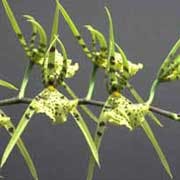
maculatus, -a, -um (mak-yew-LAY-tus) Spotted; maculate.
macule (MAK-yewl) A spot of pigment; the colored spot or mask on the base of the lip in miltonias.
maculosus, -a, -um (mak-yew-LOH-sus) Spotted; maculate.
magnificus, -a, -um (mag-NIF-i-kus) Showy; magnificent.
magnus, -a, -um (MAG-nus) Great; large; big.
majalis, -e (ma-JAY-lis) Flowering in May.
major (MAY-jor) Larger than its cogeners.
majus, -a, -um (MAY-jus) Large compared with others of the same genus.
Makino, Tomitaro (1862—1957) Prominent Japanese botanist and botanical artist who illustrated orchids of Eastern Asia.
malathion (mal-ah-THYE-on) The common name for a chemical pesticide consisting of S-(dicarbethoxyethyl) O, (O-dimethy dithiophosphate); used for the control of soft scales, spider mites, aphids and other orchid pests.
Malaxis (mal-AKS-iss) A genus 300 species of mostly terrestrial orchids found throughout the world but most abundant in tropical mountains. Related to Liparis, it was described by Swartz in 1788, the name alluding to the soft texture of the leaves.
malquique (mal-KEE-ke) Mexican term for tree fern, and also for tree-fern fiber.
mammiform (MAM-mih-form) Conical with a rounded top; breast-shaped
mammillatus, -a,-um (mam-mil-LAY-tus) Having nipple-shaped structures; mammillate.
manicatus, -a, -um (man-i-KAY-tus) With long sleeves or sheaths.
marbled (mahr-buhld) Having irregular splashes or streaks of color.
marcescent (mar-SESS-ent) Withering, but not falling off.
marginalis, -e (mar-jin-AY-lis) Placed upon or attached to the edge.
marginatus, -a, -um (mar-jin-AY-tus) Furnished with a margin or border of distinct character; marginate.
marmoratus, -a, -um (mar-mor-AY-tus) Marbled; mottled; marmorate.
Masdevallia (mas-de-VAHL-lee-ah) A genus of 380 species of epiphytic orchids from tropical America. Related to Pleurothallis, it was established in 1794 by Ruiz and Pavon, the name complimenting Dr. Jose Masdevall, a Spanish physician and botanist of the 18th century.
matutinus, -a, -um (ma-too-TYE-nus) Pertaining to or occurring in the morning; matutinal.
Maxillaria: Maxillaria tenuifolia is a popular species in the genus.
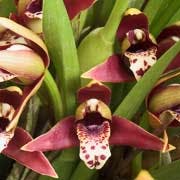
Maxillaria (mak-sil-AIR-ee-ah) A genus of 420 species of chiefly epiphytic orchids from the American tropics related to Scuticaria and Trigonidium. It was described by Ruiz and Pavon in 1794, the name alluding to the fancied resemblance of the flowers to the jaws of an insect.
maxillaris, -e (mak-sil-AIR-iss) Resembling jaws.
maximus, -a, -um (MAK-sim-us) The largest of its kind; maximal.
mealybug (MEE-lee-bug) A group of sucking insects commonly found in the leaf axils and along the inflorescences of orchids, characterized by white elliptic bodies.
mealybug: Mealybugs are not cute furry pets.
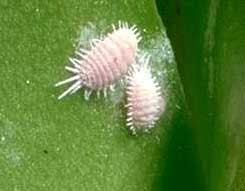
Mediocalcar: Mediocalcar decorata is a miniature orchid.
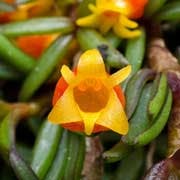
Mediocalcar (mee-dee-oh-CAL-car) A genus of 20 species of New Guinea epiphytes known for their long-lasting, brilliantly colored sepaline tubes. J.J. Smith established the genus in 1914, deriving the generic name from two Greek words meaning "middle" and "spur" to denote the saccate middle portion of the lip.
medium, media (MEE-dee-um, MEE-dee-a) (1) A nutrient substance, either liquid or jelly-like, upon which orchid seeds are germinated under aseptic or sterile conditions. (2) The substance or substratum in which an orchid plant is grown under cultivation, either organic, such as osmunda, tree fern, bark, etc., or inorganic, such as gravel, cinders, pumice, etc.
medius, -a, -um (MEE-dee-us) Intermediate; middle.
medusae (me-DEW-see) Referring to Medusa, one of the Gorgons whose locks Minerva changed into serpents.
Megaclinium (meg-ah-KLYN-ee-um) An African genus of 40 epiphytic species now included as a section of Bulbophyllum, usually characterized by broadly flattened inflorescences resembling tongue depressors.
meiosis (my-OH-sis) The reduction division that halves the number of chromosomes.
Meiracyllium (mye-rah-SILL-ee-um) A genus of two species of epiphytic or lithophytic orchids from Mexico and Guatemala allied to Laelia. Founded by Reichenbach in 1864, the name refers to the dwarf creeping habit of the plants.
meleagris, -re (mel-ee-AY-gris) Resembling or spotted like a Guinea hen.
membranaceus, -a, -um (mem-bran-AY-shus) Thin and semitransparent; skinlike; membranaceous.
Mendoncella (men-don-SELL-a) There are 11 epiphytic species in this genus ranging from Mexico south to Brazil and Peru. Hawkes identified the genus in 1963, naming it in honor of Dr. Luys de Mendon—a, editor of a Brazilian orchid journal.
meniscoidal (men-iss-KOY-dal) Like a meniscus or disk; with the form of a watch-crystal.
mentum: Dendrobium secundum showing the mentum.
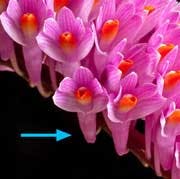
mentum (MEN-tum) A chinlike projection formed by the sepals and extended foot of the column.
mericlone (MAIR-i-klohn) A clonal orchid plantlet produced through the technique of meristem propagation.
meristem (MAIR-i-stem) The growing tissue made up of actively dividing cells, particularly at the tips of roots and at the apex of the vegetative or floral shoot.
-merous (mer-uhs) A suffix meaning having parts, as three-merous; having three parts of each kind.
mesocarp (MES-oh-karp) Middle layer or part of a pericarp; the part between the endocarp and exocarp.
mesochile (MES-oh-kyle) The intermediate or middle part of the lip of orchids whose lip is separated into three parts.
Mesoglossum (mee-so-GLOSS-um) A monotypic lithophytic or terrestrial genus native to Mexico. A member of the Odontoglossum Alliance, species in this genus have lips held at an intermediate angle to the column. Halbinger established the genus in 1984, deriving the generic name from two Greek words meaning "middle" and "tongue," a reference to the intermediate position of the lip.
mesophyte (MES-oh-fyte) A plant that only requires an average amount of water.
meter (MEE-ter) A measure of length equal to 39.37 inches or 10 decimeters; abbreviated m.
Mexicoa (meks-ih-KO-a) A monotypic epiphytic genus native to Mexico. Garay identified the genus in 1974, naming it after Mexico. Considered by many taxonomists to belong to Oncidium.
Micholitz: Phalaenopsis micholitzii was named after Wilhelm Micholitz.
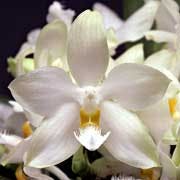
Micholitz, Wilhelm (1854—1932) A plant collector for the firm of Sanders, who collected in the Philippines, New Guinea and elsewhere. He introduced many fine orchids, including Coelogyne micholitzii from Vietnam.
microchilus, -a, -um (mye-kroh-KYE-lus) Small-lipped.
Microcoelia (mye-crow-SEE-lee-a) There are around 27 leafless epiphytic species in this genus ranging from tropical Africa to Madagascar. Lindley described the genus in 1830, coining the name from two Greek words meaning "small" and "abdomen" to denote the unique spur on these flowers.
micropropagation (mye-crow-prop-a-GAY-shun) The horticultural propagation of plants by in vitro multiplication by tissue culture (meristemming) and sterile seed culture.
micropyle (MYE-kroh-pyle) The opening of the ovule through which impregnation takes place; the point on the seed marking the orifice of the ovule.
midrib (mihd-rihb) The main vein of a leaf or leaflike part.militaris, -e (mil-i-TAY-ris) Pertaining to soldiers; like a soldier. In plants often in reference to flowers carried stiffly erect like soldiers.
Miltonia (mil-TOH-nee-ah) A genus of nine species of epiphytic orchids from South America related to Brassia, it was described in 1837 by Lindley, who dedicated it to the Earl Fitzwilliam, Viscount Milton (1748—1833) a patron of horticulture. Many plants known in horticulture as Miltonia have been reclassified as Miltoniopsis.
Miltonioides (mil-TOH-nee-OY-deez) Around five or six epiphytic species are found in this tropical Central- and South American genus. Brieger and Lueckel described the genus in 1883, selecting a name that indicated these species were similar to Miltonia.
Miltoniopsis (mill-toh-nee-OP-sis) A showy Neotropical genus of six species formerly known as the cool-growing miltonias, commonly known as pansy orchids. This epiphytic genus was described by Godefroy-Lebeuf in 1889, selecting a name to indicate that the flowers resembled those of Miltonia.
minax (MYE-naks) Threatening; forbidding.
miniata: Vanda miniata has vermillion flowers.
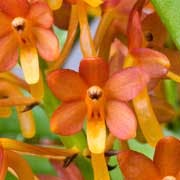
miniatus, -a, -um (min-ee-AY-tus) Vermilion-colored; cinnabar-red; miniaceous.
minimus, -a, -um (MIN-i-mus) Smallest; minimum.
minus, -a, -um (MYE-nus) Smaller.
minutus, -a, -um (mye-NEW-tus) Very small; minute.
minutissimus, -a, -um (mye-new-TISS-i-mus) The smallest; most minute.
mirabilis, -e (mye-RAB-il-is) Wonderful; remarkable; marvelous.
Mischobulbon (mih-shoh-BUHL-on) The six terrestrial species in this genus are native to Southeast Asia south to New Guinea. Schlechter described the genus in 1911, coining the name from two Greek words for "stalk" and "bulb" to describe the small pseudobulbs found in this genus.
miticide (mye-TIH-side) A pesticide used to kill mites.
mitosis (my-TOH-sis) The process of nuclear division producing daughter nuclei with the same number of chromosomes, followed by cell division; see meiosis.
mitratus, -a, -um (mye-TRAY-tus) Wearing a miter, alluding to the shape of the flower.
mitriformis, -e (mye-tri-FOR-miss) Miter-shaped, or like a cap.
millimeter (mill-ih-MEE-ter) A measure of length equal to .03937 of an inch (1/25 of an inch); abbreviated mm.
modesta: The flowers of Aerangis modesta are not very showy.
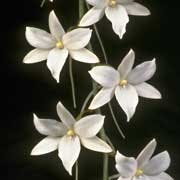
modestus, -a, -um (moh-DESS-tus) Modest; not showy or flamboyant.
Mokara (moh-KAR-ah) A hybrid genus derived from Arachnis, Ascocentrum and Vanda in 1969, and named in honor of the hybridizer C.Y. Mok.
monandrous (moh-NAN-drus) With one stamen.
moniliformis, -e (mo-nil-i-FOR-miss) Necklace-like; having alternate swellings and constrictions.
mono- (mon-oh) A prefix meaning one
monodelphous (mon-oh-DEL-fus) When stamen filaments are fused into a column or tube.
monoclinous (mon-oh-KLYE-nus) Hermaphroditic; perfect; the two sexes in the same flower. (See diclinous)
Monocotyledoneae (mon-oh-kot-ill-ee-DOHN-ee-ee) One of two subclasses of the angiospermous (seeds in a closed ovary) plants having but one cotyledon (seed-leaf), a stem that rarely exhibits secondary growth in thickness and is without annual rings, leaves generally parallel-veined, and the flowers trimerous (having parts in threes); comprising such families as the orchids, lilies, irises, palms, sedges and grasses.
monoecious (mon-EE-shus) With functional stamens and pistils in separate flowers on the same plant.
monogynous (mon-NOJ-i-nus) With only one style.
monopetalous (mon-oh-PET-a-lus) One-petaled; all the petals united to form one body or organ, as a gamopetalous corolla.
monophyletic (mon-oh-fye-LET-ick) A taxonomic and cladistic term referring to a group having a common ancestor.
monophyllous (mon-oh-FIL-us) Having a single leaf.
monopodial (mon-oh-POH-dee-al) A form of growth in which there is a single vegetative shoot that continues in growth from its terminal bud from season to season, such as in the genus Vanda.
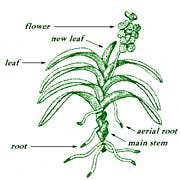
monostichous (moh-NOSS-ti-kus) In one row. (See distichous)
monstrosity (mon-STROSS-i-tee) Deformity; any unusual or atypical kind of development; a teratology.
monotypic (mon-oh-TIP-ik) Having only one type, as a genus with but one species.
montanus, -a, -um (mon-TAY-nus) Pertaining to or living in mountains; montane.
Moon, Henry George (1857—1905) Noted English botanical artist who painted most of the plates for the great orchid folios Reichenbachia (1888—1894). Commissioned by Frederick Sander, whose daughter he later married.
Mormodes (mor-MOH-deez) A genus 60 species of epiphytic or semiterrestrial orchids from tropical America, allied to Catasetum and Cycnoches. It was described by Lindley in 1836, the name alluding to the strange appearance of the asymmetric flowers.
morphogenesis (mor-foh-JEN-eh-sis) The process through which an embryo or cultured tissue develops into the final adult form.
morphology (mor-FOLL-oh-jee) The branch of biology that deals with the form and structure of plants and animals without regard to functional processes.
Mormolyca (mor-moh-LYE-ka) The six epiphytic species in this genus come from Central America and northern South America. Fenzl founded the genus in 1850, coining the name from the Greek word meaning "hobgoblin," a reference to the appearance of the flower when viewed from the side.
moscifera (ma-SKIFF-er-a) Bearing flies; alluding to the resemblance of some flowers to a fly.
moschatus, -a, -um (mos-KAY-tus) Musk-scented.
mucilaginous (mew-suh-LAJ-uh-nuhs) Mucilagelike or slimy
mucosus, -a, -um (mew-KOH-sus) With a slimy covering or secretion.
mucro (MEW-kro) A short and small abrupt tip.
mucronatus, -a, -um (mew-kron-AY-tus) Tipped with a mucro; pointed; mucronate.
mucronulatus, -a, -um (mew-KRON-ule-aye-tus) Having a small mucron, or sharp, pointed tip, used to describe the leaf apices of many orchids.
mule (mewl) An old term for a hybrid cross, particularly between different species; a hybrid.
multiflorus, -a, -um (mul-tee-FLOR-us) Many-flowered.
multigeneric (mul-tee-jen-AIR-ik) Of many genera; usually used in reference to hybrids combining several genera.
muralis, -e (mew-RAY-lis) Growing on walls.
muricatus, -a, -um (mew-ri-KAY-tus) Roughened with short, hard prominences; muricate.
muscariformis, -e (mus-ka-ree-FOR-miss) In the form of a brush or flybrush.
muscosus, -a, -um (mus-KOH-sus) Resembling a moss.
mutabilis, -e (mew-TAB-il-is) Changeable, especially as to color.
mutant (mew-TANT) An individual resulting from a mutation.
mutation (mew-TAY-shun) A change in the amount of chemical structure of DNA, resulting in a change in characteristics of a cell or organism; an individual resulting from such a change.
muticous ( mew-TEE-kos) Blunt or pointless.
muticus, -a, -um (MEW-tik-us) Blunt; without a point.
mycelium (mye-SEE-lee-um) Vegetative part of a fungus composed of threads or hyphae.
mycorrhiza (my-koh-RHYZ-ah) The condition of having symbiotic fungi associated with roots, the usual condition in orchids as well as other plant families such as the Ericaceae, or heath family.
Myoxanthus (my-oxs-AN-thus) About 40 creeping epiphytic species make up this genus that comes from Central America and South America. The genus was described in 1835 by Poeppig and Endlicher, who coined the name from two Greek words meaning "dormouse" and "flower," probably to denote how they viewed these flowers.
myrianthus, -a, -um (meer-ee-AN-thus) Innumerable-flowered.
Myrmecophila: Ants inhabit old pseudobulbs of Myrmecophila tibicinis.
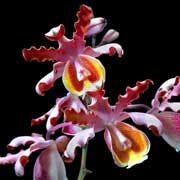
Myrmecophila (mer-me-KOFF-ill-ah) There are eight epiphytic species in this tropical Central and South American and West Indies genus. Rolfe established the genus in 1917, deriving the name from two Greek words meaning "an ant" and "a friend" to describe the association of ants with these species. Ants form colonies in the hollow pseudobulbs.
myrmecophilous (mer-me-KOFF-ill-us) Ant-loving; inhabited by ants. Mystacidium (miss-ta-SID-ee-um) A genus of nine species of epiphytic orchids from Africa. Allied to Aerangis and Angraecum, it was established by Lindley in 1836, the name derived from the Greek and referring to the bearded appendages of the column.








